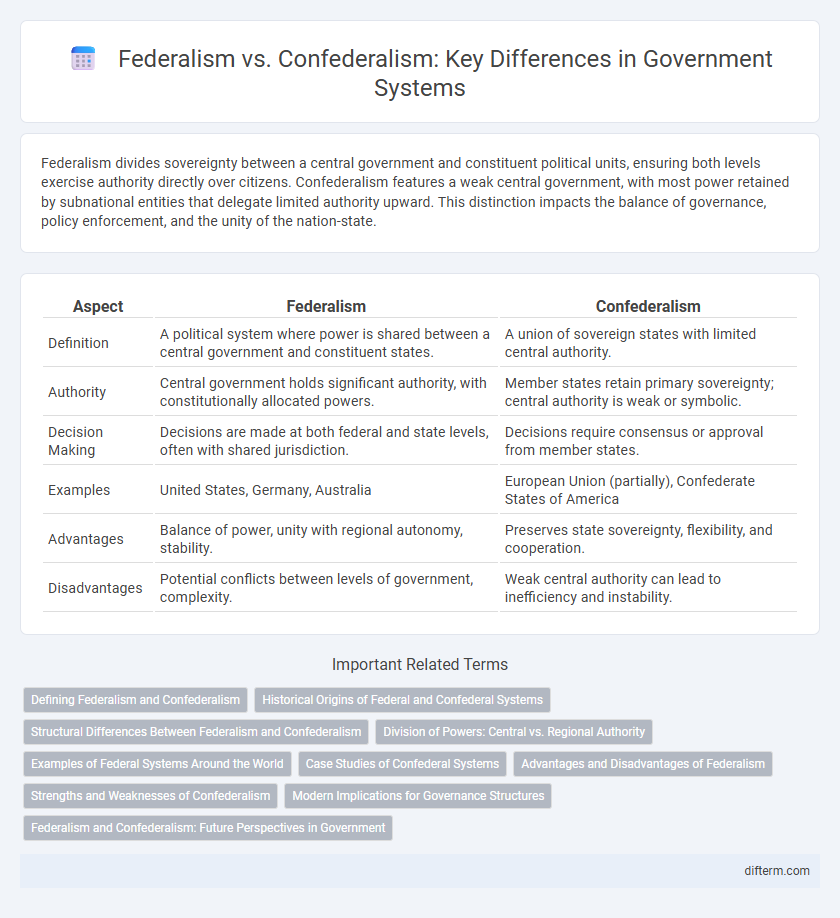Federalism divides sovereignty between a central government and constituent political units, ensuring both levels exercise authority directly over citizens. Confederalism features a weak central government, with most power retained by subnational entities that delegate limited authority upward. This distinction impacts the balance of governance, policy enforcement, and the unity of the nation-state.
Table of Comparison
| Aspect | Federalism | Confederalism |
|---|---|---|
| Definition | A political system where power is shared between a central government and constituent states. | A union of sovereign states with limited central authority. |
| Authority | Central government holds significant authority, with constitutionally allocated powers. | Member states retain primary sovereignty; central authority is weak or symbolic. |
| Decision Making | Decisions are made at both federal and state levels, often with shared jurisdiction. | Decisions require consensus or approval from member states. |
| Examples | United States, Germany, Australia | European Union (partially), Confederate States of America |
| Advantages | Balance of power, unity with regional autonomy, stability. | Preserves state sovereignty, flexibility, and cooperation. |
| Disadvantages | Potential conflicts between levels of government, complexity. | Weak central authority can lead to inefficiency and instability. |
Defining Federalism and Confederalism
Federalism is a system of government where power is constitutionally divided between a central authority and constituent political units, such as states or provinces, allowing both levels to exercise direct authority over citizens. Confederalism is a political arrangement where sovereign states delegate limited powers to a central body for common purposes, maintaining ultimate authority and independence. The distinction lies in federalism's shared sovereignty versus confederalism's retained state sovereignty with a weaker central government.
Historical Origins of Federal and Confederal Systems
Federalism originated in the United States with the 1787 Constitution, establishing a strong central government while preserving state sovereignty. Confederalism traces its roots to the Articles of Confederation, reflecting early American efforts to maintain state independence with a weak central authority. European examples, such as the Swiss Confederation, also illustrate historical confederal systems emphasizing decentralized governance.
Structural Differences Between Federalism and Confederalism
Federalism features a strong central government with constitutionally recognized authority over subordinate units, ensuring a balance of power between national and regional governments. Confederalism, by contrast, consists of a weak central authority where sovereign states retain ultimate power and delegate limited functions to the central body. The structural difference lies in the distribution of sovereignty, with federalism centralizing authority and confederalism preserving state independence.
Division of Powers: Central vs. Regional Authority
Federalism balances power by granting sovereign authority to both central and regional governments, enabling regional entities to legislate independently within constitutional bounds. Confederalism concentrates authority primarily in regional governments, with the central body exercising limited control, often dependent on regional consent for decision-making. This division of powers shapes governance structures, affecting policy implementation, conflict resolution, and political stability across regions.
Examples of Federal Systems Around the World
Federal systems like the United States, Germany, and Australia exemplify how power is constitutionally divided between national and subnational governments, allowing for regional autonomy. In these countries, state or provincial governments have significant authority over areas such as education, transportation, and law enforcement while coordinating with the federal government on national issues. This balance enables tailored policies that address local needs while maintaining national unity and stability.
Case Studies of Confederal Systems
Confederal systems feature a union of sovereign states granting limited powers to a central authority, as seen in the European Union, where member states retain substantial autonomy while collaborating on common policies. The Articles of Confederation in early U.S. history exemplify a confederal model with a weak central government that depended heavily on state cooperation. Switzerland's decentralized governance also highlights confederal principles, balancing cantonal independence with federal functions on issues like defense and foreign relations.
Advantages and Disadvantages of Federalism
Federalism offers advantages such as enhanced local governance, allowing constituent states or regions to address specific needs and preferences effectively while promoting political stability through power-sharing. It can also encourage policy innovation and competition among states, fostering efficient public service delivery and protecting minority rights by decentralizing authority. However, federalism may lead to inconsistencies in laws and regulations across regions, potential conflicts between state and federal governments, and complexities in coordination that can hinder uniform national policies and economic integration.
Strengths and Weaknesses of Confederalism
Confederalism emphasizes regional autonomy by granting significant powers to constituent units, fostering local decision-making and protecting cultural diversity. However, this decentralization often leads to weak central authority, resulting in challenges for national cohesion, defense coordination, and uniform policy implementation. The system's reliance on voluntary cooperation can cause instability and inefficiency in addressing collective issues at the federal level.
Modern Implications for Governance Structures
Federalism establishes a strong central government with constitutionally guaranteed powers shared with regional entities, ensuring national unity while allowing local autonomy. Confederalism relies on a loose alliance of sovereign states with limited central authority, often resulting in decentralized policy-making and potential challenges in enforcing collective decisions. Modern governance structures favor federal systems for their ability to balance centralized authority and regional diversity, enhancing political stability and efficient resource distribution.
Federalism and Confederalism: Future Perspectives in Government
Federalism and confederalism represent distinct frameworks for distributing power between central and regional governments, with federalism featuring a strong national authority balanced by constituent states, while confederalism prioritizes regional sovereignty with limited central power. Future perspectives indicate an evolving hybrid approach, as governments seek flexible models to manage complex socio-political landscapes, emphasizing cooperation, shared governance, and regional autonomy. Emerging trends in federal systems focus on enhancing intergovernmental collaboration and constitutional adaptability to address globalization, decentralization, and multicultural governance challenges.
federalism vs confederalism Infographic

 difterm.com
difterm.com